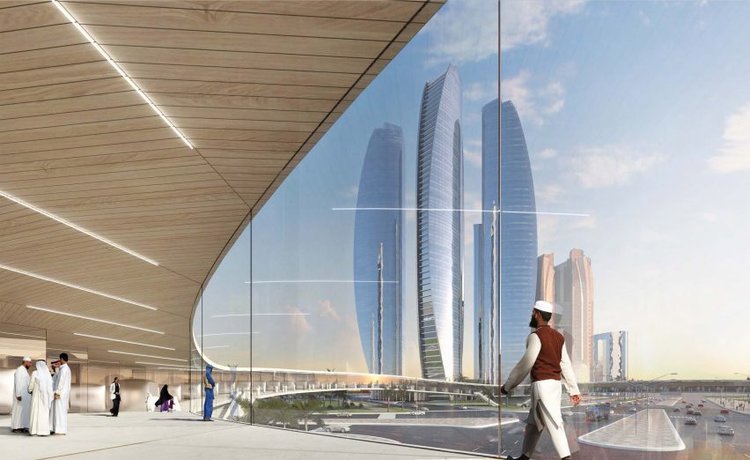It really should come as no surprise. Odd though it may be, so much construction innovation these days seems to detour through the desert, and more often that not, it runs right through Dubai, UAE.
Now, assuming all systems are go, the world’s first hyperloop — the Elon Musk-inspired ground-based transport and propulsion system seeking speeds of 700 mph — could also soon make its first practical debut in Dubai, already home to the world’s tallest building, and now also an enthusiastic global leader in 3D-concrete printing for offices and labs.
“Dubai is a city that understands global change and seizes the opportunity to pioneer,” explained Mattar al-Tayler, head of Dubai’s Roads and Transport Authority (RTA), while announcing the ambitious new hyperloop endeavor. RTA has inked a deal with Los Angeles-based Hyperloop One, Danish architect Bjarke Ingels Group (BIG), and management consultant McKinsey & Co. to perform feasibility studies on hyperloop routes linking Dubai and UAE capital Abu Dhabi.
“Hyperloop One combines collective commuting with individual freedom at near supersonic speed… We are heading for a future where our mental map of the city is completely reconfigured”
Should a route come to fruition, it could reduce a 99-mile, two-hour car ride to a mere 12 minutes. UAE anticipates completing the route in only five years and integrating it within a network of hyperloops extending across the Gulf region. One suggested route would reduce the two-hour plane ride between Dubai and the Saudi capital of Riyadh to 50 minutes, and at a fraction of the price.
“We don’t sell cars, boats, trains, or planes,” said Josh Giegel, Hyperloop One’s co-founder and president of engineering. “We sell time.”
Time travel? Well, yes, indirectly. And to make it palatable to the human body, more than a little style will be needed to soften the physical jolt of super-fast solo commuting. That’s were BIG comes in.

“Hyperloop One combines collective commuting with individual freedom at near supersonic speed,” said Bjarke Ingels, BIG’s founding partner, in releasing the above video earlier this month. “We are heading for a future where our mental map of the city is completely reconfigured, as our habitual understanding of distance and proximity – time and space – is warped by this virgin form of travel… We have given form to a mobility ecosystem of pods and portals, where the waiting hall has vanished along with waiting itself.”
Let that sink in for a moment. Commuting without waiting?
The deal, announced in early November, isn’t Hyperloop One’s first with Dubai. In October, the firm also received $50 million in related funding from ports operator DP World Group to work on development of a hyperloop cargo off-loader.
To date, Hyperloop One has seemingly pulled away from its competitors, achieving its “Kitty Hawk moment” in the Nevada desert last May. With global press watching, a 1,500-lbs bare metal sled elevated by magnetic levitation technology rocketed down a 984-ft-long track, accelerating from zero to 60 mph in just 1.1 seconds. The firm subsequently raised $80 million in investments. To date, despite a highly publicized management shakeout, the firm has still raised an additional $80 million in capital.
- Reality v. Fantasy > Below, Hyperloop One’s “Kitty Hawk moment” from last May in Nevada.
However, its end product remains under development. First full-scale testing could occur as soon as early next year at Hyperloop’s Nevada test site, Hyperloop One CEO Rob Lloyd indicated in a statement, adding the enterprise hoped to have “multiple operational Hyperloop systems within five years.”
In addition to UAE, the firm will also perform feasibility studies for the Dutch and Finnish governments. One plan under review would link Helsinki to Stockholm in just 30 minutes. The firm also is developing passenger and cargo routes for Russia and Switzerland while participating in the LA-San Francisco link in the U.S. “Basically, we are looking to do a big raise next year,” Giegel told reporters. “If we can have a customer on the hook, it will be all that much easier.” Indeed, Dubai seems to fit the bill.
Why Dubai?
Due to it wealth, UAE may be more likely to spend enormous sums of money on hyperloop technology than the U.S., Jim McGregor, principal analyst with high-tech consultant Tiras Research, told reporters.
At present, plans call for launching pods from several circular stations throughout Dubai. Autonomously driven square pods will queue up for one of four spots within a larger pod propelled through a tube from Dubai to Abu Dahbi. “Pods can seat anywhere from six to 100 people as comfortably as a living room,” Hyperloop One indicated in a statement. “Companies can have their own custom meeting pods. Families can have their own pod. There could even be a critical-care pod to whisk patients to hospitals.”
All told, 120 pod gates within stations will accommodate more than 8,500 passengers per hour, according to Hyperloop One.
It’s an ambitious agenda for a five-year project. As Lloyd has put it, “We do aspire to build the world’s first hyperloop in the United Arab Emirates. That is our aspiration. We have a lot of work to do.”

Discussion
Be the first to leave a comment.
You must be a member of the BuiltWorlds community to join the discussion.